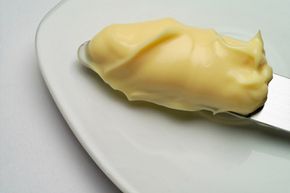Mayonnaise is a thick, creamy sauce or dressing that is made of oil, egg yolks, lemon juice or vinegar, and seasonings. It's not the same as salad dressing, which doesn't contain egg yolks and is generally sweeter than mayonnaise.
Mayonnaise is an emulsion, which is a mixture of two liquids that normally can't be combined. Combining oil and water is the classic example. Emulsifying is done by slowly adding one ingredient to another while simultaneously mixing rapidly. This disperses and suspends tiny droplets of one liquid through another.
Advertisement
However, the two liquids would quickly separate again if an emulsifier were not added. Emulsifiers are liaisons between the two liquids and serve to stabilize the mixture. Eggs and gelatin are among the foods that contain emulsifiers. In mayonnaise, the emulsifier is egg yolk, which contains lecithin, a fat emulsifier.
Chemically, emulsions are colloids, heterogeneous mixtures composed of tiny particles suspended in another immiscible (unmixable) material. These particles are larger than molecules, but less than one one-thousandth of a millimeter (.001mm). Small particles like this do not settle out and will pass right through filter paper. The particles in a colloid can be solid, liquid or bubbles of gas. The medium that they are suspended in can be a solid, liquid or gas (although gas colloids cannot be suspended in gas).
Emulsions are liquid-liquid colloids, tiny liquid droplets suspended in another liquid. Emulsions are usually thick in texture and satiny in appearance.
Emulsions are used in many different ways:
- by pharmacists, as a vehicle for medication
- in photography, to coat plates, film and paper
- in explosives, paints, coatings, make-up and detergents
- in food, including baked goods and confectionery products
Mayonnaise is made by combining lemon juice or vinegar with egg yolks. Eggs (containing the emulsifier lecithin) bind the ingredients together and prevent separation. Then, oil is added drop by drop as the mixture is rapidly whisked. Adding oil too quickly (or insufficient, rapid whisking) will keep the two liquids from combining (emulsifying). But, as the sauce begins to thicken, oil can be added more rapidly. Seasonings are whisked in after all of the oil has been added. Blenders, mixers and food processors make it easy to make homemade mayonnaise, which many gourmets feel is far superior in taste and consistency to commercial mayonnaise.
Since homemade mayonnaise is uncooked, be sure to use the freshest eggs possible, and ones that you are reasonably sure are free from salmonella. Homemade mayonnaise will last three to four days in the refrigerator.
Commercial mayonnaise, which will last up to six months in the refrigerator, contain (by U.S. law) at least 65-percent oil by weight (except reduced-fat and fat-free mayonnaises). The standard of identity law also requires that all commercial "real mayonnaise" use only egg as an emulsifier. Reduced fat mayonnaise, which isn't considered real mayonnaise, usually contains modified food starch, cellulose gel and other thickeners and emulsifiers.
Mayonnaise is used as the base for other sauces, such as tartar sauce and thousand-island salad dressing. Aioli is garlic-flavored mayonnaise. Another classic emulsion sauce is hollandaise, which is a cooked mixture of butter, egg yolks and lemon juice.
Advertisement
